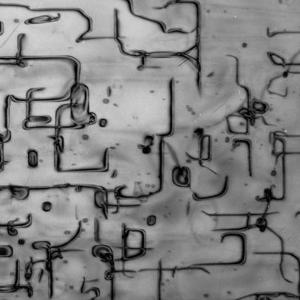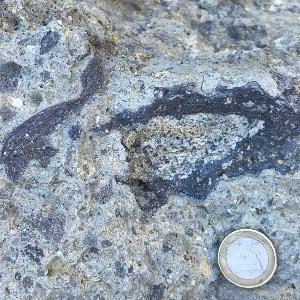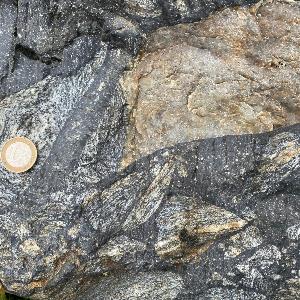Prof. Dr. Claudia Trepmann
Professorin für Geologische Deformation und Transformation von Gesteinen, Dekanin
Sprechstunde:
Thursday 12:00-14.00


TEM bright field micrograph of dislocations in experimentally deformed olivine, image width ≈ 3 µm | © Claudia Trepmann
Rheology of rocks is relevant for all topics dealing with material fluxes in the various spheres of our Earth. How rocks behave under external stresses governs for example plate tectonics, earthquakes, volcanism and convection in the Earth’s interior. We use experimentally deformed rocks in comparison to the natural deformation record to evaluate the rheology of rocks.
Research projects
Neuste Forschungsergebnisse: Claudia A. Trepmann, Lina Seybold (2019): Deformation at low and high stress-loading rates. Geoscience Frontiers,https://doi.org/10.1016/j.gsf.2018.05.002

Suevite, impact breccia from the Ries impact structure, Germany | © Claudia Trepmann
Impact cratering is a fundamental geological process shaping the surface of planetary bodies. Shock effects are microstructures that form upon the impact of asteroids in the target rocks. They provide unique information on the highly dynamic processes and conditions during impact cratering. Impact craters represent valuable natural laboratories to understand processe
Research project: Formation and deposition of suevites.
C.A. Trepmann (2008): Shock effects in quartz: Compression versus shear deformation — An example from the Rochechouart impact structure, France. Earth and Planetary Science Letters, Volume 267, Issues 1–2, 1 March 2008, Pages 322-332, https://doi.org/10.1016/j.epsl.2007.11.035

Field image of Silvretta-pseudotachylyte
Fault rocks represent the damage involved during faulting. They carry valuable information on the grain-scale deformation processes and conditions also at depths in the Earth’s crust that are not accessible by any other technique. We use field geology and state-of-the-art microfabric analysis in combination with experiments to analyze the deformation record of fault rocks. An understanding on the processes at depth is required to understand how earthquakes develop, which might help to better deal with the natural hazard of earthquakes.
Research projects
Neuste Forschungsergebnisse: Brückner, L. M., Trepmann, C. A., & Kaliwoda, M. (2023). Rheology dependent on the distance to the propagating thrust tip—(ultra-)mylonites and pseudotachylytes of the Silvretta basal thrust. Tectonics, 42, e2023TC008010. https://doi.org/10.1029/2023TC008010

EBSD-map of inclusions of coesite (Coe, high-pressure polymorph of SiO2) in pyrope (Prp, Mg-rich garnet), partly back-transformed to quartz(Qz) indicating ultra-high-pressure metamorphism. | © Claudia Trepmann
Subduction zones represent first order geological structures in plate tectonics. My special interest are the deformation and transformation of rocks at conditions during subduction zone metamorphism and the influence on the material flow in the Earth’s interior. What are the stresses in subduction zones, how are subduction zone earthquakes generated, how are rocks exhumed from depth of ≥100 km in geologically very fast time scales? These and similar questions are addressed by reading the geological record of metamorphic rocks that were exhumed from the subduction channel.
Research project: High stress crystal plasticity of carbonates - episodic deformation at transient stresses. PIs: Claudia Trepmann, Elena Sturm (DFG proposal).
Sara Wassmann, Bernhard Stöckhert, Claudia A. Trepmann, 2011. "Dissolution precipitation creep versus crystalline plasticity in high-pressure metamorphic serpentinites", Deformation Mechanisms, Rheology and Tectonics: Microstructures, Mechanics and Anisotropy, David J. Prior, Ernest H. Rutter, Daniel J. Tatham DOI:https://doi.org/10.1144/SP360.8